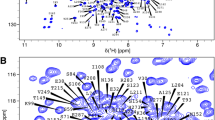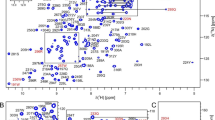Abstract
The plasmid-encoded small multidrug resistance pump from S. aureus transports a variety of quaternary ammonium and other hydrophobic compounds, enhancing the bacterial host’s resistance to common hospital disinfectants. The protein folds as a homo-dimer of four transmembrane helices each, and appears to be fully functional only in lipid bilayers. Here we report the backbone resonance assignments and implied secondary structure for 2H13C15N Smr reconstituted into lipid bicelles. Significant changes were observed between the chemical shifts of the protein in lipid bicelles compared to those in detergent micelles.


Similar content being viewed by others
References
Chen YJ et al (2007) X-ray structure of EmrE supports dual topology model. Proc Natl Acad Sci USA 104:18999–19004
Delaglio F, Grzesiek S, Vuister GW, Zhu G, Pfiefer J, Bax A (1995) NMRPipe: a multidimensional spectral processing system based on UNIX pipes. J Biomol NMR 6:277–293
Grinius LL, Goldberg EB (1994) Bacterial multidrug resistance is due to a single membrane protein which functions as a drug pump. J Biol Chem 269:29998–30004
Korkhov VM, Tate CG (2009) An emerging consensus for the structure of EmrE. Acta Crystallogr D Biol Crystallogr 65(Pt 2):186–192
Krogh A, Larsson B, von Heijne G, Sonnhammer ELL (2001) Predicting transmembrane protein topology with a hidden Markov model: application to complete genomes. J Mol Biol 305:567–580
Krueger-Koplin RD et al (2004) An evaluation of detergents for NMR structural studies of membrane proteins. J Biomol NMR 28:43–57
Lee D, Hilty C, Wider G, Wüthrich K (2006) Effective rotational correlation times of proteins from NMR relaxation interference. J Magn Reson 178:72–76
Littlejohn TG et al (1991) Structure and evolution of a family of genes encoding antiseptic and disinfectant resistance in Staphylococcus aureus. Gene 101:59–66
Mchaourab HS et al (2008) Role of sequence bias in the topology of the multidrug transporter EmrE. Biochemistry 47:7980–7982
Poget SF, Krueger-Koplin ST, Krueger-Koplin RD, Cahill SM, Chandra Shekar S, Girvin ME (2006) NMR assignment of the dimeric S. aureus small multidrug-resistance pump in LPPG micelles. J Biomol NMR 36(suppl 1):10
Poget SF, Cahill SM, Girvin ME (2007) Isotropic bicelles stabilize the functional form of a small multidrug-resistance pump for NMR structural studies. J Am Chem Soc 129:2432–2433
Prosser RS, Volkov VB, Shiyanovskaya IV (1998) Novel chelate-induced magnetic alignment of biological membranes. Biophys J 75:2163–2169
Rapp M et al (2007) Emulating membrane protein evolution by rational design. Science 315:1282–1284
Schuldiner S (2009) EmrE, a model for studying evolution and mechanism of ion-coupled transporters. Biochim Biophys Acta 1794:748–762
Ubarretxena-Belandia I, Baldwin JM, Schuldiner S, Tate CG (2003) Three-dimensional structure of the bacterial multidrug transporter EmrE shows it is an asymmetric homodimer. EMBO J 22:6175–6181
Venters RA, Farmer BT II, Fierke CA, Spicer LD (1996) Characterizing the use of perdeuteration in NMR studies of large proteins: 13C, 15N and 1H assignments of human carbonic anhydrase II. J Mol Biol 264:1101–1116
Vranken WF, Boucher W, Stevens TJ, Fogh RH, Pajon A, Llinas M, Ulrich EL, Markley JL, Ionides J, Laue ED (2005) The CCPN data model for NMR spectroscopy: development of a software pipeline. Proteins 59:687–696
Wishart DS, Sykes BD (1994) The 13C chemical-shift index: a simple method for the identification of protein secondary structure using 13C chemical-shift data. J Biomol NMR 4:171–180
Wishart DS, Bigam CG, Yao J, Abildgaard F, Dyson HJ, Oldfield E, Markley JL, Sykes BD (1995) 1H, 13C and 15N chemical shift referencing in biomolecular NMR. J Biomol NMR 6:135–140
Yamazaki T, Lee W, Arrowsmith CH, Muhandiram DR, Kay LE (1994) A suite of triple resonance NMR experiments for the backbone assignment of 15N, 13C, 2H labeled proteins. J Am Chem Soc 116:11655–11666
Acknowledgments
This work was supported by NIH grant GM072085. Many of the NMR experiments were performed at the New York Structural Biology Center, which is a STAR center supported by the New York State Office of Science, Technology, and Academic Research; its 900 MHz spectrometers were purchased with funds from NIH, USA, the Keck Foundation, New York State, and the NYC Economic Development Corporation.
Author information
Authors and Affiliations
Corresponding author
Rights and permissions
About this article
Cite this article
Poget, S.F., Harris, R., Cahill, S.M. et al. 1H, 13C, 15N backbone NMR assignments of the Staphylococcus aureus small multidrug-resistance pump (Smr) in a functionally active conformation. Biomol NMR Assign 4, 139–142 (2010). https://doi.org/10.1007/s12104-010-9228-7
Received:
Accepted:
Published:
Issue Date:
DOI: https://doi.org/10.1007/s12104-010-9228-7




